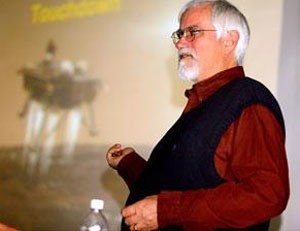UA research is officially no longer just a product of planet Earth.
After a successful landing Sunday, the UA took over science operations for NASA’s Phoenix Mars Lander, making the UA the first university to run a NASA Mars Mission.
Radio signals received at 4:53 p.m. confirmed that the Phoenix Lander had survived its final descent through the Martian atmosphere and successfully touched down on the planet’s surface.
The news was delivered to a cheering crowd of Arizona team members and their families and friends who had gathered at the Science Operations Center at UA’s Lunar and Planetary Laboratory.
“”I’m so excited, so relieved. It was getting so stressful at that point (the landing), and now it’s like—ah, we can relax now,”” said Cherie Achilles, a UA graduate and mission engineer.
The atmosphere surrounding the landing was exciting, but tense. Over half the attempts to land instruments on Mars have ended in failure. Five years of work hung in the balance for the assembled team members as ‘Phoenix’ made a series of complex maneuvers to slow from 12,000 mph to 5 mph to touch down safely on Mars, according to event officials updating the project’s status throughout the night.
After the successful landing had been confirmed, images relayed back to earth from ‘Phoenix’ confirmed that the craft’s solar panels had fully deployed, meaning the mission can be powered for at least the next 90 days, said Pat Woida, a UA mission engineer.
UA graduate and undergraduate students will now begin working with scientists from Arizona and around the world. University students will be given pivotal responsibilities on the mission, said Roger Tanner, the project’s lead engineer.
“”We don’t ask them to do simple things. We ask them to do complex things,”” he said. “”We ask them to take what they learned in school and apply it. It’s like their fist sort of real job.””
‘Phoenix’ landed on an area of Mars roughly equivalent to Canada’s Northwestern Territories on Earth. It will use its robotic arm to dig up and analyze the ice that is below the surface of high latitude Mars. The hope is that the ice samples and land material will give clues as to whether or not the conditions for biological life once existed on Mars, said Peter Smith, the project’s principal investigator.
The control center on Earth will receive additional periodic updates from the lander over the next several weeks concerning the project’s status, Smith said.









